 Access Key Details
Access Key Details
Early Talkies
This page contains selected articles from old UK radio magazines dealing with the early days of radio and television.
This page contains articles dealing especially with early film and sound systems
I have no idea if these ancient articles are copyright or who would own it- if anyone wishes to claim content and ask for it to be acknowledged or removed, do please contact me. I can find no indication that anyone else has this material and physically it won't last much longer.
Note: The first article relates to General Electric (RCA), whose system became known as Photophone and used a variable area whereas the second article relates to Movietone which used a variable density. The Movietone variable density system faded out as Western Electric produced their own improved variable density system. Projection equipment became able to handle either Photophone or Western Electric formats. By the end of 1936 the Photophone system (the first described below) became a clear leader.
Cinematograph and Sound Records on the Same Film
Article by A. DINSDALE
IN the issue of this journal for September 15th, 1926, the writer described a very successful talking moving picture system which had just then been demonstrated in New York. In the following article it is proposed to describe another system of talking movies which has just been developed by a different group of engineers belonging to the General Electric Company.
Cinematograph performances, or movies, as they are called in America, have been developed until they have now reached a very high pitch of perfection. The same applies to sound reproduction, whether through the medium of the gramophone or by means of electrical apparatus; and the present-day perfection in the latter direction owes much to broadcasting, for many of the methods used in broadcast transmission and reception have been adapted to mechanical and electrical sound reproduction.
The problem to be solved in the development of a suecessful talking moving picture system, therefore, is simply one of accurate synchronisation of a visible record (the cinematograph film) with a record of the accompanying sounds.
Efforts to do this date back about twenty years. In the article referred to above (15/9/1926), the writer described the Vitaphone productions, in which simultaneous records of scenes and sounds are made on a film and a gramophone record respectively. During this and the subsequent process of reproduction, synchronism is obtained by electro-mechanical means.
The New System
In the General Electric Company's system both records are made on the same medium- a standard width cine-matograph film. A standard motion picture camera is used for making the picture, and a standard projector, with an attachment for the sound reproducer, is used for the presentation of the two effects.
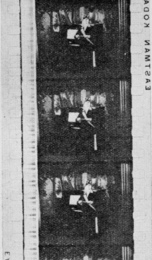 The sound record is made along the margin of the film, where there is a strip a small fraction of an inch wide upon which can be seen a series of horizontal light and dark bands and lines, of varying widths and intensities. It is this series of bands and lines which produces the sound.
The sound record is made along the margin of the film, where there is a strip a small fraction of an inch wide upon which can be seen a series of horizontal light and dark bands and lines, of varying widths and intensities. It is this series of bands and lines which produces the sound.
In making the new films the scene is shot in the usual manner with an ordinary cinematograph camera. Somewhere out of range of the camera is mounted a suitable form of microphone, the output current of which is suitably amplified by means of ordinary L,F. amplifiers.
The amplified current is caused to actuate a tiny vibrating mirror, which reflects a tiny spot of light through a lens and on to the margin of the film. The result is, therefore, an oscillograph record of the sounds.
This sound record can be made in different ways. Both the picture and the accompanying sounds can be simultaneously recorded on the same film by mounting the two recording elements as a unit, with the sound recorder uppermost.
The two recorders can also be mounted separately, and the sound and picture film negatives made as individual units, such an arrangement being preferable when the pictures are being made in studios and when the camera is being shifted constantly. In this case the cameras making the two records must be driven by synchronous motors to ensure synchronism between the two records.
Again, as in the case of music to accompany an important feature film, the picture film can be entirely finished and titled, the record of the music then being made on a separate film and the two combined on the finished positive.
The Projector and Reproducer
The only modification from standard in the projector is the attachment which can be seen just below the upper drum which holds the films.
This attachment consists simply of a small electric lamp and a photoelectric cell. The former, together with a suitable lens, is placed in front of the film, while the latter is placed behind it. As the film is run through the projector a small spot of light is caused to shine upon the margin of the film, and the intensity of light which ultimately reaches the photoelectric cell depends upon the density of the oscillograph record on the edge of the film.
The result of this action is that a very minute and varying current, an exact replica of the sound wave, is produced in the output circuit of the cell. This tiny current is then amplified by means of ordinary L.F. amplifiers and fed to a loud-speaker which reproduces the sound in sufficient volume to fill the auditorium.
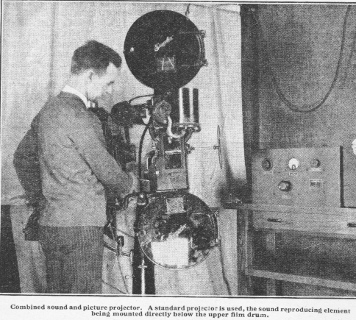 Any suitable loud-speaker can be used; The one for large auditoriums which has been used in the demontrations is a Hewlett loud-speaker, chosen because of its ability to give the necessary volume, and because of the quality of tone reproduction of which the device is capable.
Any suitable loud-speaker can be used; The one for large auditoriums which has been used in the demontrations is a Hewlett loud-speaker, chosen because of its ability to give the necessary volume, and because of the quality of tone reproduction of which the device is capable.
Synchronism Assured
Cinematograph films are extremely fragile things. Before they have been exhibited very many times they commence to tear at the edges and even break. Such damage makes it necessary to cut out as much as six or eight feet of film before a satisfactory repair can be made.
Ordinarily the amputation of such small sections of film in this manner is unnoticeable when the picture is next exhibited, unless the film is very old and has suffered many breakages.
Any system of talking films which employs two separate records for the scenes and accompanying sounds immediately comes up against a serious problem of synchronisation when the film breaks. Obviously, if a portion of the film is cut out without a similar portion of the sound record being eliminated, the delicate timing of the entire system is bound to be thrown out of gear.
In the system under review however, the timing cannot be thrown out, for the sound record is on the edge of the film. Consequently if the film breaks the appropriate part of the sound record comes out along with the picture record.
Although the picture does not suffer to any noticeable extent when a few feet of film are cut out, it might he thought that the sound reproduction would suffer. Experience has proved that such is not the case, however, for as a rule only a letter or two of a word is lost.
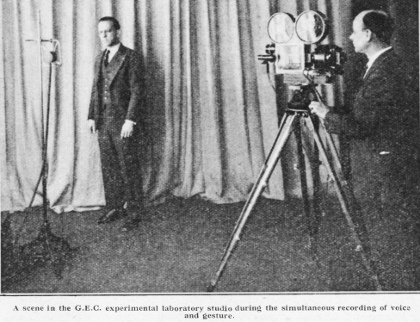
Another point in favour of the system is that if the film should happen to break during exhibition- not an infrequent occurrence-- it is impossible for the sound reproduction to continue. It must stop simultaneously with the reproduction of the scene.
The System Demonstrated
The new apparatus was demonstrated in New York recently before an audience of radio engineers and moving picture theatre owners. While the demonstration was
confined to orchestration, singing and a few introductory remarks by an announcer who appeared in the films, the results obtained were exceptionally good.
The films were very good and very well presented, and the quality of the sound reproduction left little to be desired.
Those who are accustomed to attend the presentation of big feature films in the largest cities know that a suitable orchestral accompaniment is of vital importance if the film is to be followed and appreciated to the fullest extent. One has only to witness a presentation of the same film in a small town, where the picture- house orchestra consists merely of a decrepit piano, indifferently played, to appreciate this point.
By means of a talking movie system the necessary orchestral accompaniment, played by a first class orchestra, can be recorded on the film, circulated round the
provincial theatres, and properly presented there, so that the small town picture goer can enjoy the benefit of a performance equal to that possible to the city dweller.
 Fields of Application
Fields of Application
A feature of the General Electric system is the extreme rapidity with which the photographic records of sound and action can now be made. A demonstration of this was given when the orchestra of the Capitol Theatre, New York, commenced at midnight to play music to accompany The Flesh and the Devil.
Synchronism in this case was obtained by making both records simultaneously on the same film, and the entire film was complete and ready for presentation by noon the next day.
Another field of application is in connection with news reels. Not only will it be possible to show important personages when they attend public functions; they will also be able to address a few words to the audience, and visiting notables will be able to extend their greetings.
It is not usually possible for famous musicians and orchestras to appear in small communities. Talking motion pictures will permit them to be both seen and heard in the most remote corners of the country.
From an educational standpoint there are also many ways in which the new development will be of service. Many schools and colleges are now equipped with cinematograph apparatus as an aid to class-room work, and the new films will be found of even greater assistance.
In America broadcasting has been called in to aid education, and by this means it has been found possible for eminent lecturers in certain subjects to reach remote
class-rooms and thus enabled them to benefit students who could not possibly have hoped to hear such masters of their subject in any other way.
Where demonstrations are necessary concomitants to a lecture, however, broadcasting cannot be employed, and this is where the talking film can step in and supply the want. In the case of professors from abroad, it will be possible to record their lectures and demonstrations simultaneously, and thus render their lectures of the greatest possible value by the circulation of the film to colleges and universities throughout the country.
These are but a few of the possible fields in which the new talking motion pictures will find applications. The list can and will be extended.
Thus we have one more development to add to the rapidly growing list of inventions which depend for their successful operation upon apparatus which was originally developed for use in connection with radio communication, the foundation stone being that modern Aladdin's lamp, the thermionic valve .
[note: In using sound on separate disk or on an optical film track each system had its advantages. As the optical track was on the master film, and a viewer might be watching a 3rd or 4th (or more) generation copy, there was a degree of loss, just as the picture contrast was lost, and dirt on the film became clicks. The web site owner has watched an original cinema print of a 1930 film where the soundtrack was on Vitaphone record for one reel then on optical soundtrack for the next reel etc. The elderly gramophone disk had the edge for quality over the optical track. Sharper and better high frequencies. The usual hiss of an old record was quickly forgotten. If anything the faded and dirty optical soundtrack was noisier.]
14th December 1927-
The Movietone-
A highly developed talking film system giving remarkably realistic reproduction
by W. I. G. Page, B.Sc.
Just as the three-electrode valve is being utilised to improve the reproduction from gramophone records, so it would appear to be destined to play a big part in the development
of kinematography. No one visiting the New Gallery Kinema, where the Movietone talking film is being shown, can fail to be impressed by the extraordinary advances that have lately
been made in fidelity of reproduction and realism of effect, for which due credit must be paid to the Western Electric Company, backed by the research department of the
Bell Telephone Laboratories.
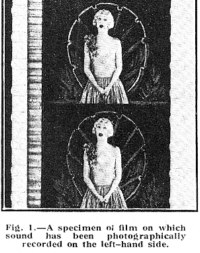
It needs a keen sense of relative values to appreciate the merits of design of a speech amplifier and series of loud-speakers which can magnify many million times the minutest sound impulses represented by a tiny flickering beam of light not more than one thousandth of an inch broad, and deliver them to an audience of, say, 1,500 people with a volume and faithfulness which is practically the same as the original. The synchronisation of realistic speech and music with the film undoubtedly adds a new interest for the cinema goer and it would appear safe to predict that in a few years time most of the larger cinemas will be equipped with apparatus for synchronous sound reproduction.
The Movietone system of talking films involves the photographic recording of sound on a one tenth of an inch margin of the standard 1.375 inch film, using a standard camera and a standard projector, to which are easily fitted special additional apparatus; simultaneous with the recording of sound the associated scene is photographed on the rest of the film, and when developed and printed as a positive presents an appearance as shown above.
There are a number of methods whereby the marginal record of sound is obtained.
Action of the Photo-electric Cell
In general the sound waves picked up by a microphone are converted into electric pulsations and are passed to a low frequency valve amplifier and made to actuate an electromagnetic mechanism similar to the movement of a small loud-speaker, which, being between a bright source of light and a narrow slit near the film in the camera, causes the light through the slit to oscillate in sympathy with the original sound waves and so vary the exposure on the edge of the film.
The small diaphragm which causes the light to oscillate naturally has mass, and therefore a natural period of vibration, which may fall within the frequencies associated with music and speech, thus giving undue prominence and an unnatural effect to certain notes; reference will be made later to means of neutralising this defect.
As an alternative to the above electromagnetic method of recording, it should be mentioned that in some films the sound-track is made by the A.E.O. flashing lamp scheme.
The sound represented by tiny lines of varying depth and opacity on the film have now to be converted in turn to light fluctuations, electric pulsations, and ordinary sound waves, and it is this part of the article which may be of special interest to the wireless enthusiast, as it is concerned in discussing the best means of getting a tremendous volume of undistorted signals using no less than seven stages of Low Frequency (L.F.) amplification.
The first process of creating light fluctuations is achieved within a standard projector by arranging that a small pilot light, with a short, stout filament giving a brilliant point source of light, is set so that its rays are directed by means of lenses through a one thousandth of an inch slit on to the margin of the moving film. The light beam of varying intensity thus formed is now directed on to a light sensitive cell which changes its electric resistance sympathetically.
There are two types of these cells available, namely, selenium and photo-electric. The former has the advantage of developing a higher light-dark current ration, but suffers from lag, while the latter develops a relatively much smaller current change but is instantaneous in action, and is used in the system under discussion.
In order to understand the functioning of the photo-electric cell, light must be considered as an electromagnetic disturbance, and matter as consisting of atoms built up of aggregates of electric charges with positive nuclei surrounded by negatively charged electrons.. When an electromagnetic wave falls on an atom of metal, for instance, it is not unreasonable to expect that the equilibrium of opposite charges will be upset, and that electrons will become detached. Actually in practice this is the case, and the effect is found to be most pronounced with electropositive metals such as sodium, potassium and rubidium.
The theory has been put forward that the vision of the human eye is due to the detecting of electrons from the rod and cone cells by photo-electric action.
The Movietone cell is a glass body which internally deposited metal in vacuo; the detached electrons are attracted to the central collecting ring, which is maintained at a constant positive potential. So small are the oscillations from the collecting ring that is hat been thought advisable to have as short a lead as possible to the first three stage L.F. amplifier, necessitating the housing of this unit within the body of the projector, which is subject to heavy vibration and to the influence of commutator disturbance and an arc lamp passing 100 amperes. Complete spring suspension and earthed metal screening, however, guard against any spurious effects.
[At this point the article goes into excessive technical detail about resistances, anodes, grid leaks and so on. If anyone ever reads this page and requests the detail I will insert it or email it]
Importance of Volume Control:
Reference has already been made to the accentuation of certain frequencies due to the natural period of vibration of the light diaphragm in the camera; this resonance peak is neutralised by a filter circuit contained within the equaliser.
There are many factors which militate against realistic effect even if the quality of reproduction is perfect. The comparative volume at which each item must be delivered is very important. For instance, the cheering by a crowd at a football match must be presented relatively much louder than a speech by some dignitary; furthermore, it is necessary that the amplifier be short-circuited during periods when there is no sound accompaniment to the film. It is therefore arranged that the volume control or fader is within easy reach of the operator, who alters it according to pre-arranged settings obtained at rehearsals. [Further more technical details removed here]
To create the illusion that speech or music is coming from any point between the top of the special sound-porous screen and the orchestra pit, two loud-speakers are put in each of these two positions [top and bottom of screen] so that by distributing the ratio of output to either pair by means of individual controls the desired effect is obtained. Careful attention must be paid to the apparent location of sound origin, as was evinced in a demonstration given to the writer of this article of the grotesque effect of making speech come from a mans forehead! In this connection it would appear inadvisable to exhibit close-up pictures of people's faces as subjects for Movietone accompaniment.
[Technical details of 14 foot logarithmic 10 watt speakers removed from here]
The ordinary motor which is used to drive a standard projector is not sufficiently steady in speed for Movietone reproduction; a special motor is supplied which is automatically controlled by a three electrode valve regulator. If for any reason the speed of a sound recording film changes, a sudden alteration in pitch occurs which is very noticeable. The constant speed motor serves the dual purpose of preventing change in pitch and of providing a means of synchronously driving a gramophone turntable for use with records which have been made by the Vitaphone process soon to be exploited in this country. By this method the impulses from a gramophone pickup are applied to the same amplifiers and loud-speakers as those used with the Movietone, but orchestral music of general appeal can be played as an accompaniment to any suitable film which is not of the sound recording type.
Movietone equipment is not sold outright, but leased on terms which allow the patentees to withdraw the apparatus if it is operated in a way which is prejudicial to their interests (this idea might sometimes well be applied by wireless set manufacturers!). When the price of the installation is reduced, as will surely occur with increased demand, the effect of its introduction to the country cinema to replace the piano handled by the village belle, will be astonishing. It can now be safely said that synchronised electric reproduction of sound as a substitute for an orchestra is un fait accompli.
Sept 1940- Photographic Methods of recording Sound on Film
By R. F. E. MILLER
(B.B.C. Technical Recording Section)
An outline of the principal methods employed in recording sound on photographic film. Variable area and variable density systems are discussed, and it is shown how background noises are reduced
WHEN, in 1927, or thereabouts, the cinema finally found its voice, the idea of sound recording on film was already many years old. In 1900, Ruhmer, a German, was photographing sound on film, the sound track, occupying almost the whole available width of the film, being produced by modulating the intensity of a "singing" arc. Reproduction was effected by passing a beam of light through the film and thence on to a light-sensitive selenium cell.
In 1918-1919, Petersen and Poulsen, of Denmark, were recording sound on film, using mirror oscillographs, while in 1923-24 the Germans, Engl, Vogt, and Masolle, and the American, de Forest, were producing vari able density records by means of a process using gas discharge tubes.
Today the mirror oscillograph and the gas discharge tube, together with a variable density system using a "light valve," form the basis of photographic recording of sound on film.
In the photographic recording of sound a track is formed in which the modulation is represented by the variations in the amount of light that will pass through a given area of this track at any instant. This area, in practice, is the full width of the track, approximately 0.001 inch deep, and is technically known as the light slit.
Now it will be obvious that we can vary the track in two different ways to produce the same effect. Either we can have a uniformly transparent track of varying width, or we can vary the general opacity of the track, keeping its width constant. Both these systems are used, the former being known as the variable area, and the latter as the variable density system.
In making a record of the variable area type, a rectangle of light from a recording lamp is projected on to the mirror of a recording galvanometer. This galvanometer consists of a loop of wire stretched over two ivory
bridges and kept under tension by a spring attached to the closed end of the loop. To the two arms of the loop where they pass over the bridge a tiny mirror is attached.
This loop is placed in the field of a permanent magnet so that the wires lie across the plane of the magnetic flux. A current passing through the loop will therefore tend to make the two arms rotate about each other, the direction of rotation being determined by the direction of the current. The application of speech currents will cause the arms (and therefore the mirror attached to them) to vibrate in sympathy.
Moving Iron Galvanometer
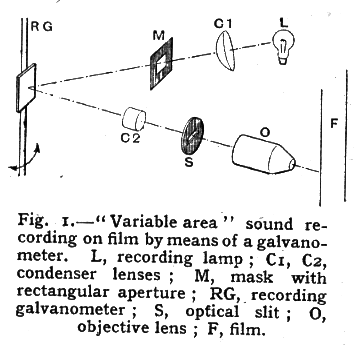 A later type of galvanometer developed for recording purposes is of the moving iron type, the mirror being mechanically coupled to the armature. The virtual image formed in the mirror is in turn projected on to a narrow slit in an opaque mask, and an objective lens in turn projects an image of this slit on to the photographic tilm. A schematic diagram of the system is shown in Fig. 1.
A later type of galvanometer developed for recording purposes is of the moving iron type, the mirror being mechanically coupled to the armature. The virtual image formed in the mirror is in turn projected on to a narrow slit in an opaque mask, and an objective lens in turn projects an image of this slit on to the photographic tilm. A schematic diagram of the system is shown in Fig. 1.
Matters are so arranged that when no voltage is being applied across the galvanometer one edge of the rectangle of light bisects the optical slit that is, we have an optical slit illuminated along half its length.
The application of a vo1tage across the galvanometer will rotate the mirror and cause the rectangle of light to embrace more or less of the optical slit, according to the direction of the applied voltage.
This optical slit, with its varying length of illumination, being projected as a sharply defined image on to the photographic film, which is moving at a steady rate of 18 inches per second in a direction at right angles to the length of the projected slit, produces on development a sound track negative of the type shown in Fig. 2(a).
Whilst this system as it stood gave fair results, it had many defects. One of the most noticeable and objectionable shortcomings was an excessive amount of background noise, which, unfortunately, became progressively worse with each "playing," until low levels of modulation were lost in an excess of "mush."
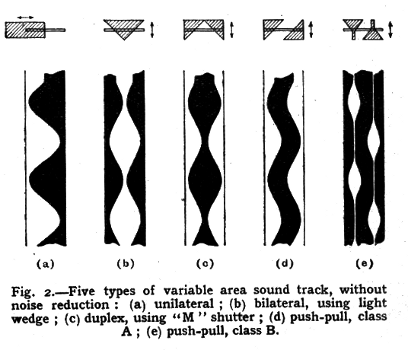 The cause was modulation, of the photoelectric cell by scratches and abrasions on the clear portion of the sound track. This problem was solved by rectifying a portion of the speech currents, thus obtaining a voltage to bias back the recording galvanometer, or actuate a shutter, so that the amount of clear film in the positive copy
got progressively less as the modulation decreased.
The cause was modulation, of the photoelectric cell by scratches and abrasions on the clear portion of the sound track. This problem was solved by rectifying a portion of the speech currents, thus obtaining a voltage to bias back the recording galvanometer, or actuate a shutter, so that the amount of clear film in the positive copy
got progressively less as the modulation decreased.
Another trouble experienced was distortion of the higher frequencies, especially at high modulation levels, due to the excessively steep wave face, the spaces or valleys between the waves becoming clogged during the subsequent developing and printing processes.
One can liken this trouble to the clogging by dust, etc., of the spaces between the teeth of a fine tooth comb - the higher the frequency the more teeth per inch, and consequently the smaller the clearance between them.
By projecting a triangular "wedge" of light on to the optical slit, instead of a rectangle, and causing this to oscillate across it a sound track of the form shown in Fig. 2(b) is produced, in which `it will be seen that for a given frequency and depth of modulation an increase in the angle between adjacent wave faces is obtained.
A modified form of this light "wedge" now extensively used is the "M" type aperture, producing a track of the form shown in Figs. 2(C) and 3(c).
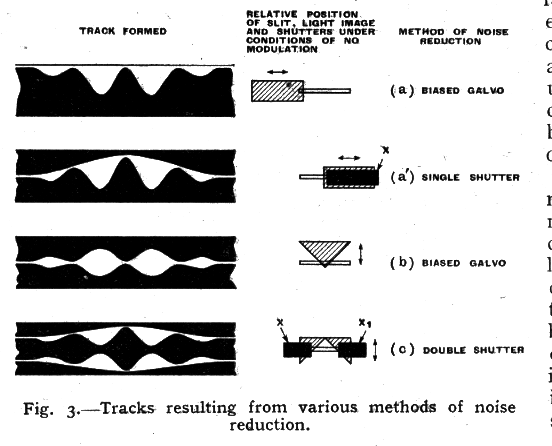 A double noise reduction shutter x, xi (see Fig. 3) is used, the two portions of which close towards the centre of the track during periods of low modulation, occupying the position shown in the diagram during periods of no modulation, and opening out from each other as the modulation increases.
A double noise reduction shutter x, xi (see Fig. 3) is used, the two portions of which close towards the centre of the track during periods of low modulation, occupying the position shown in the diagram during periods of no modulation, and opening out from each other as the modulation increases.
The production of a variable density record necessitates that the optical slit will, at all times, be illuminated
along its whole length, but that the intensity of the illumination should be variable.
In practice two methods are employed. In one system a gas discharge tube is used as the source of light. A steady striking voltage is applied across this, and superimposed upon it are the speech voltages, which vary the amount of light about its mean value. The modulation voltages must not, of course, swing the voltage across the tube beyond the quenching or overload values. No optical system is necessary, as the film is drawn past an optical slit in contact with the tube.
The other system of variable density recording employs a light valve, the intensity of the light source remaining constant. In its essentials the light valve consists of a loop of duralumin tape, stretched tight under spring tension, the central portion being held by insulation to form a slit 0.001 inch wide.
This loop is placed in a magnetic field in a plane at right angles to the flux. A current passing through the loop will cause it to open or close, according to the direction of the current. It will be realised that we have, in effect, a shutter whose opening and closing we can vary in sympathy with applied speech currents.
By mounting the ribbons in slightly separated planes, clashing together at periods of over-modulation with attendant risk of mechanical damage will not occur.
The light from the recording lamp is focused by the condenser on to the slit of the light valve, an image of this illuminated slit being focused on to the film by an objective lens.
Sound Reproduction
To reproduce either type of recording, a light image the full width of the track and 0.0013 inch wide is focused on the film, and this light, passing through the film, impinges on to a photoelectric cell.
As the film is moving at a uniform velocity past the projected light slit, the variations in the opacity of the track will cause variations in the amount of light falling on the photoelectric cell, the voltages thus produced being amplified and finally fed to the loud speakers.
The principles of push-pull have been applied to both variable area and variable density film recording with the object of minimising or eliminating certain distortions in the same manner as it has been applied to valve amplifiers.
Although space does not permit this type of recording to be gone into very deeply, we might note the main points. Push-pull film recording is classified under three headings - Class A, Class B, and Class AB. In Class A the signal energy is divided to form two identical tracks 180 degrees out of phase. In Class B one track records the positive half-cycles, whilst the other track records the negative half-cycles. In Class AB, which is of an experimental nature, the recorder is so adjusted that low levels are recorded as Class A and high levels as Class B. Reproduction of either class requires an amplifier with a push-pull input using two photo-electric cells, or a photo-electric cell having two anodes and two cathodes.
As photographic considerations play such an important part in these recordings it will not be out of place to touch upon them here. The light transmission of a variable area type of recording at any point is directly related to the ratio between the dark and light portion of the track, consisting as it does of a combination of opaque image and clear film. It does not, therefore, depend upon gradations of exposure for either output or quality, and, provided that the density of the exposed portion is constant and of sufficient opacity, a satisfactory recording from the photographic standpoint is obtained.
This state of affairs is fairly easily realised in practice as the only two factors governing the exposure are the light intensity and the speed of the film. Variable density recording, however, depends for its modulation upon variations in the densities or transmission values of the track. The photographic requirements for this type of recording are therefore somewhat more exacting.
The main application of photographic sound recording is perhaps in connection with the cinema, but it has many other applications. The G.P.O. talking clock (or TIM) uses a photographic sound track on circular glass discs, while there is at least one commercial radio-gramophone designed to use film records instead of the more familiar disc.
Contact me
Access Key Details
 The sound record is made along the margin of the film, where there is a strip a small fraction of an inch wide upon which can be seen a series of horizontal light and dark bands and lines, of varying widths and intensities. It is this series of bands and lines which produces the sound.
The sound record is made along the margin of the film, where there is a strip a small fraction of an inch wide upon which can be seen a series of horizontal light and dark bands and lines, of varying widths and intensities. It is this series of bands and lines which produces the sound.
 Any suitable loud-speaker can be used; The one for large auditoriums which has been used in the demontrations is a Hewlett loud-speaker, chosen because of its ability to give the necessary volume, and because of the quality of tone reproduction of which the device is capable.
Any suitable loud-speaker can be used; The one for large auditoriums which has been used in the demontrations is a Hewlett loud-speaker, chosen because of its ability to give the necessary volume, and because of the quality of tone reproduction of which the device is capable.

 Fields of Application
Fields of Application

 A later type of galvanometer developed for recording purposes is of the moving iron type, the mirror being mechanically coupled to the armature. The virtual image formed in the mirror is in turn projected on to a narrow slit in an opaque mask, and an objective lens in turn projects an image of this slit on to the photographic tilm. A schematic diagram of the system is shown in Fig. 1.
A later type of galvanometer developed for recording purposes is of the moving iron type, the mirror being mechanically coupled to the armature. The virtual image formed in the mirror is in turn projected on to a narrow slit in an opaque mask, and an objective lens in turn projects an image of this slit on to the photographic tilm. A schematic diagram of the system is shown in Fig. 1.
 The cause was modulation, of the photoelectric cell by scratches and abrasions on the clear portion of the sound track. This problem was solved by rectifying a portion of the speech currents, thus obtaining a voltage to bias back the recording galvanometer, or actuate a shutter, so that the amount of clear film in the positive copy
got progressively less as the modulation decreased.
The cause was modulation, of the photoelectric cell by scratches and abrasions on the clear portion of the sound track. This problem was solved by rectifying a portion of the speech currents, thus obtaining a voltage to bias back the recording galvanometer, or actuate a shutter, so that the amount of clear film in the positive copy
got progressively less as the modulation decreased.
 A double noise reduction shutter x, xi (see Fig. 3) is used, the two portions of which close towards the centre of the track during periods of low modulation, occupying the position shown in the diagram during periods of no modulation, and opening out from each other as the modulation increases.
A double noise reduction shutter x, xi (see Fig. 3) is used, the two portions of which close towards the centre of the track during periods of low modulation, occupying the position shown in the diagram during periods of no modulation, and opening out from each other as the modulation increases.